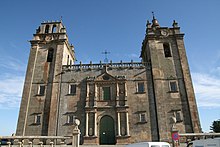Miranda do Douro co-cathedral
The co- cathedral Santa Maria ( Igreja de Santa Maria Maior in Portuguese ) consecrated to the Virgin Mary in the north-eastern Portuguese border town of Miranda do Douro in the Tras-os-Montes region is - next to the modern cathedral of Bragança - the seat of the Roman Catholic diocese Bragança-Miranda .
location
The south-facing co-cathedral is located on the southern edge of the old town of Miranda do Douro, about 1 km on foot and about 100 m in altitude from the Douro River at an altitude of about 750 m .
history
In 1545 Pope Paul III raised at the request of King João III. the border town of Miranda do Douro to the episcopal city. The construction of the cathedral, designed and built one after the other by the architects Gonçalo de Torralva, Miguel de Arruda and Francisco Velasquez, began in 1552; its completion took place essentially in the last decade of the 16th century - that is, during the personal union of Portugal with Spain (1580-1640). In 1770 the bishopric was moved to Bragança and ten years later the diocese of Bragança was established by Pope Pius VI. with the Apostolic Constitution Romanus Pontifex renamed “Diocese of Bragança and Miranda”.
architecture
The stone material used in the exterior is granite . This and the straightforward severity of the facade design are largely influenced by the Escorial monastery palace, which was built around the same time . Nevertheless, the central part of the facade is somewhat loosened up by pairs of columns arranged one above the other with a central triangular gable .
The interior of the church has three aisles ; the busted rib vaults in the central nave and in the side aisles are at the same height ( hall church ). While the side aisles end in - externally encased - apses , the middle choir chapel (capela-mor) is extended to the south and closes flat.
Furnishing
The altar retable of the main altar erected in 1614 is the work of the carver Gregorio Fernández, who lives and works in Valladolid , or his workshop; it belongs to the late Renaissance style epoch . Other side chapels mostly have smaller baroque altars .
Altarpiece of the main altar
See also
Web links
- Miranda do Douro Co-cathedral - photo + quick facts
- Miranda do Douro co-cathedral - photos + info (monument, portuguese)
Individual evidence
Coordinates: 41 ° 29'35 " N , 6 ° 16'24.3" W.





